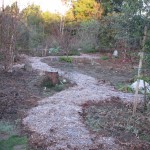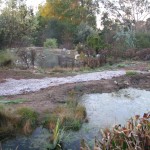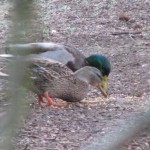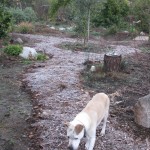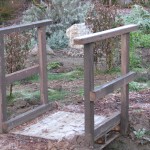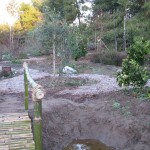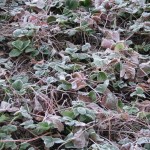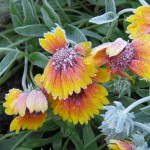- Animals, Chickens, Compost, Gardening adventures, Hugelkultur, Permaculture and Edible Forest Gardening Adventures, Soil, Worms
Strawberry-flavored Hugelkultur, Please
A few months ago my daughter and I thinned out the raised strawberry bed.

Way too many plants. I planted the extra strawberries under the passionvine arch,
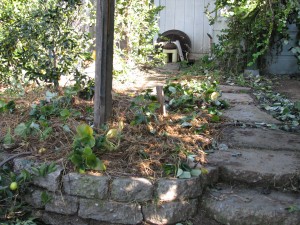
Under the passionvine trellis. using well pooed and pecked and rained-upon straw from the Fowl Fortress as mulch.
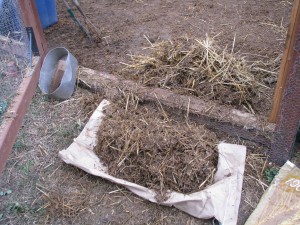
Good yucky straw. However the soil level in the raised bed has become lower, and the Bermuda grass has grown higher. Time for a re-do.
When I’d originally planted the bed a few years ago, I’d heard about burying wood to hold moisture and improve the soil. Some little thing we call… hugelkultur. I laid old lime tree logs along one side. They began to break down and some really cool mushrooms came up.
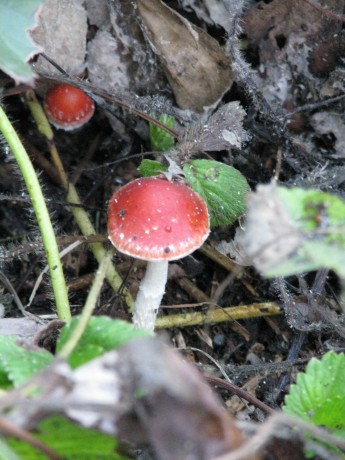
Cool mushrooms. Strawberries sent runners out and they rooted right in the wood. A great success.
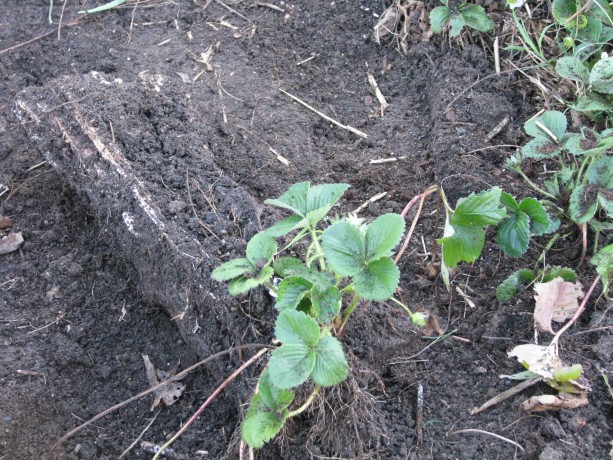
Strawberries rooted right in the wood! Since I don’t have ready compost to fill such a large bed right now, I decided to do the hugel-thing in the entire bed. I spent several hours digging out the strawberries and the Bermuda grass.
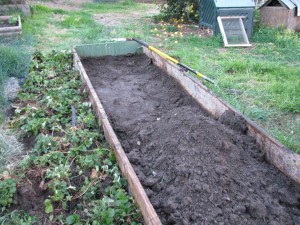
Making the bed: everyone out! Then I pulled the soil back and was simply amazed.
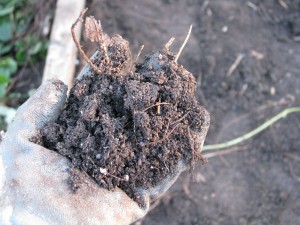
Beautiful soil It was crumbly like prime worm castings. I lined the bottom of the raised bed with the logs on top of the wire I’d laid across the bottom to deter gophers and mice.
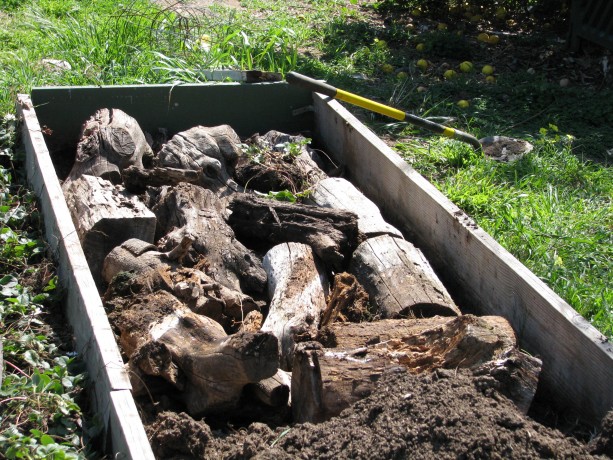
Old lime logs. Then I shoveled heavy clay out of the new bog area and threw that in and around the logs; the wood would decompose and turn the clay to great soil, and the clay already had a lot of interesting microscopic creatures in it from being at the edge of the pond.

Heavy clay. And I do mean heavy. On top of that I sprinkled some pigeon guano I recently received from some wonderful new friends who rescue pigeons. (They are wonderful even if they hadn’t given me the guano. I have many friends who, in fact, are guano-less. Just to clarify.) There were a lot of pigeon peas in the guano, but if they sprout its all good because they are nitrogen fixers and will only help things along. Some sugar was added to help stir up the bacteria in the clay.All along I watered everything in, including hosing down Lark the fat, barren Barred Rock hen who just wouldn’t take no for an answer and kept jumping into the bed to steal the worms!
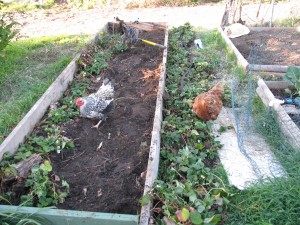
Get away from my worms, hens! My hens are such prima-donnas that they refuse to eat sowbugs and just go for worms. Geez! Lark got back at me later by making me come after her when it was time to shut them in for the night.
The last layer on the bed (and I don’t mean a chicken) was the good soil into which I replanted the strawberries. I did this process in thirds and ended up with a lot of extra strawberries.
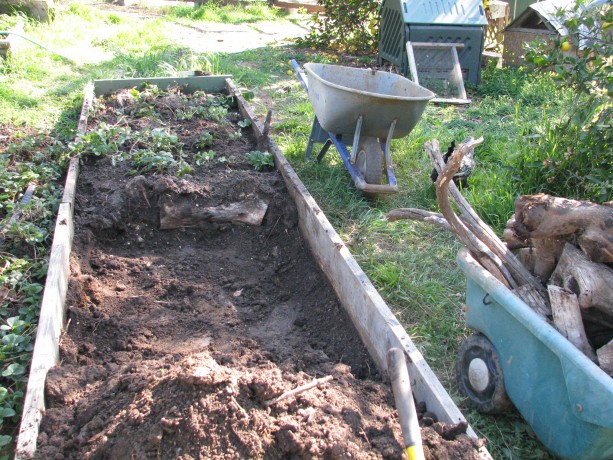
A third section done. As it was nearing sunset and I was becoming chilly in my shorts and sleeveless shirt, I hurriedly planted the extras up under the passionfruit trellis, in with the others from the previous planting. Most of them had happily survived.
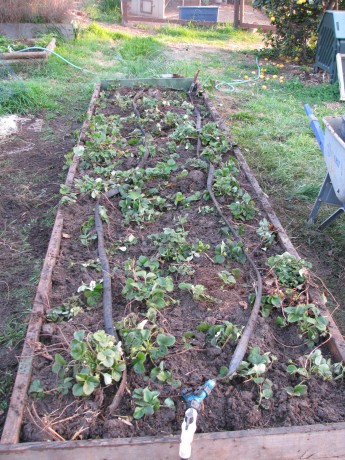
Finished! The leftover soil I sprinkled on top, laid the soaker hose back on top, and voila! A somewhat shocked but hopefully soon-to-be-happier strawberry bed.
There are a couple of wild mallards that come to the pond and have grown trusting of me up to a point. I throw game bird food by the pond for them. I don’t want to tame them, but I like it that they don’t fly off in a fright every time I come near. Its better for their health not to be so stressed. Makes me feel good, too.
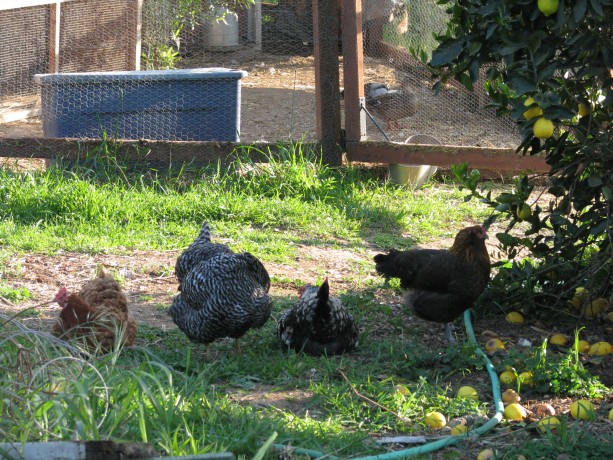
Hen line-up. But what is in the coop behind them? While I was digging I looked up to find my hens all in a row watching me, and beyond them inside the Fowl Fortress (the door of which I’d propped open) were the two mallards! They were perfectly content to be eating what the hens hadn’t eaten, and were even sitting in there enjoying… I don’t know… forbidden territory?
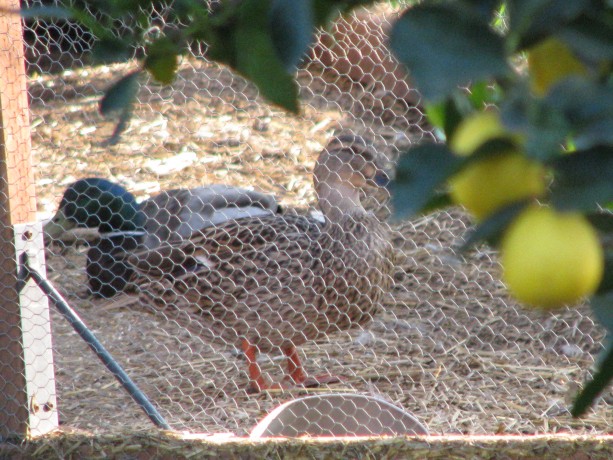
Just make yourself at home! The alluring and romantic smell of chicken poop? After awhile Miss Amelia wandered in there and the mallards wandered out. They’re welcome in there, but if they want me to build them a castle of their own, forget it. They already have the floating duck house, after all!
- Compost, Composting toilet, Gardening adventures, Hugelkultur, Permaculture and Edible Forest Gardening Adventures, Ponds, Rain Catching, Soil
Rain Catchment Awesomeness (and some BSP)

Water flowed over the stone steps First, a little BSP (blatant self-promotion). There is a wonderful ezine called San Diego Loves Green featuring topical local articles and snippets that reflect on the growing green community here in, you guessed it, San Diego. The San Diego Permaculture Group has an ongoing column, and yesterday I was the guest writer. My article is on the importance of planting natives , with some information that you might find surprising, or that you may have already read in my blog about the same subject. Also (more BSP) if any of you attended the Southern California Permaculture Convergence this weekend, and still yet, if any of you listened to my talk on soil, first of all I’d like to thank you for your attention and attendance, and I hope I answered your questions and solved some problems for you. You can search on my blog for many posts concerning nitrogen -fixing, or 50 Ways to Leave Your Compost , and see my composting toilet (I went to a Garden Potty).
We had almost two inches of rain on Thursday night. In San Diego we rarely receive the long soaking rains that we really need. Instead we must be ready for flash floods. If you are familiar with Finch Frolic and the labors we’ve been undertaking in the last two years to hold the rainwater, then you may be curious to find out how the property survived this last middle-of-the-night flooding and hailstorms. If you remember, not only is there the water flowing off the roof and falling onto the watershed property, but also an unmeasurable amount that is purposely channelled runoff from all the neighbor’s properties that runs through mine.
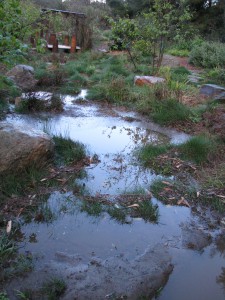
All basins full! Since the permaculture project was installed I haven’t had any of the erosion that plagued the site. As of last year I’m pretty sure that every drop that falls on my property is caught, in rain catchment basins, the ponds, and in the loam and compost in the guilds. The challenge was to also keep all the neighbor’s water on my property as well! I’m thrilled to say that we almost did it!
There is a new bog area being designed by Jacob Hatch just above the big pond.
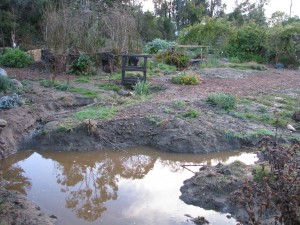
The new bog area This area had been designed to channel overflow water from the rain catchment streams around the pond and down a black tube to the stream bed below. Greedy me wants all that water! With the creation of another silt basin, and now that there is vegetation in the stream to hold onto the silt, I’ve made the water now flow directly into the big pond. There are planned overflows from the big pond, and water did overflow where it was supposed to.
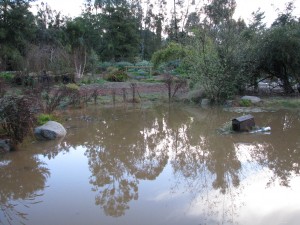
The big pond was filled to capacity, making the duck house do a sinking ship impression because of the length of the rope attached to the anchor wasn’t long enough. The first rain catchement basin was enlarged a lot so as to catch water higher on the property.
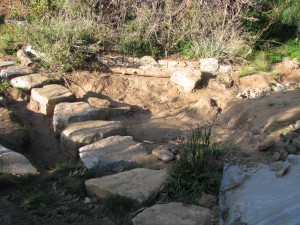
The first catchment basin was deepened There is decomposed gravel in that one so the water perculates quickly, thank goodness, as most of the other basins hold water due to the clay composition of the soil.
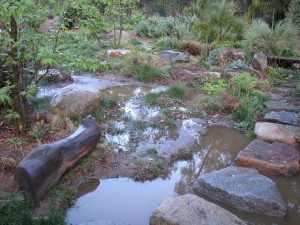
Water following the basins. Also, a rain catchement basin was created along the top of the cement channel that normally funnels water off the property.
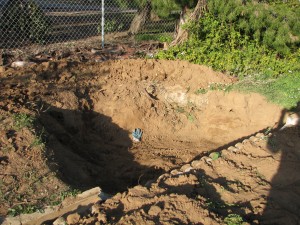
New basin, empty A series of these will be created all along the channel, allowing water to slow, gather and perculate along the length of the property, with no outlet at the end.
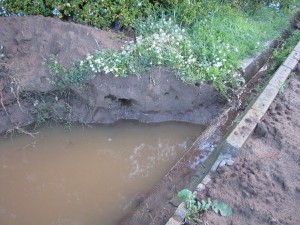
Full! This will take some of the flow pressure off of the water diverted down into the main series of basins.
The only area breached was actually due to a gopher hole whose origin must be in the stream. I could tell by the swirls in the mulch where the erosion happened.
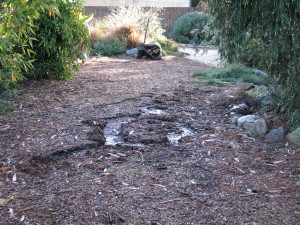
Swirls tell of a breach. There is also the slight problem of water flowing down my own driveway and then down the trail.
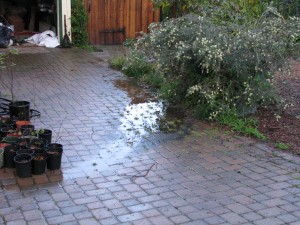
Water funneled down my driveway. I think a small hugelkultur bed might slove that problem.
The verdict? Almost all the water was retained on the property,even that of the neighbor’s! A few tweaks and we are well on our way to total rainwater dominance! Mwwahahahahahahaha!

Mwwahahahahahahaha! - Compost, Gardening adventures, Hugelkultur, Permaculture and Edible Forest Gardening Adventures, Rain Catching, Soil, Vegetables
Hugelkultur: Irrigating with old wood
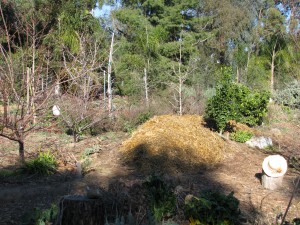
Hugelkultur is a joy forever. Hugelkultur is a German word (pronounced hoogle culture: it should have some umlauts over the first ‘u’ but I have no idea how to do that) which translates as hill culture. It is a process of building raised beds with a core of old wood. The benefits are that as the wood decomposes it not only releases nutrients into the soil, but it holds water like a sponge. Rain water is collected inside the bed, then as the warmer weather sets in and heat dries out the outer shell, it will wick that moisture back out. Presto! Irrigation in the dry season. As the wood decomposes it creates air holes into which deeper roots may penetrate and absorb nutrients that aren’t being washed into the ground water. Also, growing on a tall hugelkultur bed makes harvesting easier because vegetables are often located higher off the ground. The process was popularized by Sepp Holzer, although he didn’t actually call it that.
Hugelkultur may be started flat on the ground, by hand or by machine, dug into the ground, stacked very tall or short, or even level to the ground. The best way to build a bed is to place it on contour where rainwater will collect, preferably facing North and South so that both sides receive equal sun.
I have areas of ground that are either very heavy clay, or are decomposed granite with stones left over from the building of the house. Some trees don’t receive the drainage they need from irrigation because of the clay, which causes the roots to suffocate, or else plants dry up because water perculates too swiftly through the soil.
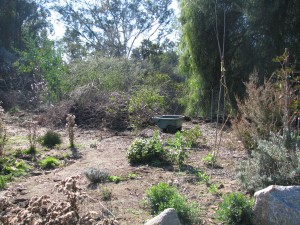
This brush pile against the fence was reduced to a quarter of its size. I also have stacks of brush that were left when the garden was created as hiding places for animals while the garden grew. I don’t need that many brush piles anymore now that the garden is large. I have three wire cages filled with woodier weeds and prunings that are in ‘slow compost’ mode, and leftover trimmings from bamboo used in bridge construction. Perfect hugelkultur components!
I targeted an area between the pathway and a plant guild with two apricots and vegetables in it. When it rains that area has standing water on it because of the clay content. The area should become part of the guild, but the soil needs mucho amending. I have areas like this all around the property. How to amend two acres of soil? How to get rid of the ever-rising mountains of prunings? How to make the rain water permiate the soil and perculate down rather than sheet across? One guess. Yep, hugelkultur. I bury that wood!
I had made a small hugelkultur experiment a year ago with a raised strawberry bed. There was old lime firewood rotting on the property, so I placed several of these logs along the side of the bed, then covered them with soil and planted strawberries. It worked very well. The strawberries loved the acid, even growing into the decomposing logs, and the logs held the moisture. Some wonderful showy fungus came up, too. I will be reworking that bed and this time I will cover the ground with logs, throw on some llama or horse manure, cover with compost and replant the strawberries. I shouldn’t have to fertilize that bed or add soil for a long time.
For the big hugelkultur bed I wanted a deep hole that would capture rain and allow the wood to absorb it. My faithful assistants Lori and Steve and Jacob work on this project with me. Steve and Lori dug this ginormous serpentine pit about 2 1/2 feet deep and the same wide.

Lori and Steve digging a huge trench. Since the paths had just been covered with mulch, the dirt was piled on top of plywood layed over the mulch for protection.
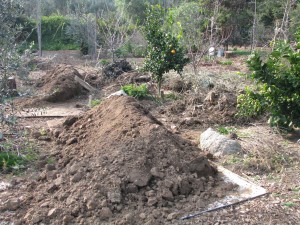
Plywood over the paths helped keep things neat and tidy. Then we began filling the bed with the largest wood first.

The empty trench with still-intact drip systems over it. We didn’t have large logs which would have worked well, but we had lots of thick branches. This hole took a lot of prunings and we jumped on them to compact them down.
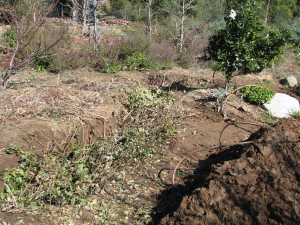
A bear trap! There are a lot of branches in this pit. The hugelkultur bed was left for a few days to settle (and we had run out of time and energy that first day!), and then we worked on it again. Extra dirt from the rain catchment basins that the men were enlarging was hauled down and thrown into and around the wood.
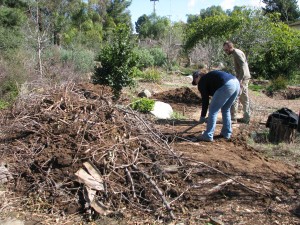
Dirt was added to the mix The mound was watered well. In dry areas it is important to water the wood and the soil well as you are building or else the bed will want to draw water from the area around it, drying up any seeds or plants planted on it.

Some of the long pieces that really stuck out were pruned off. Of course if this is a temporarily boggy area, the hugel bed would help dry it out. There were subterranean irrigation lines across the area already, and since we have a dry climate and the wood I used wasn’t old spongy logs and would take some time to become absorbant, we reestablished the drip system across the top of the hugel bed.
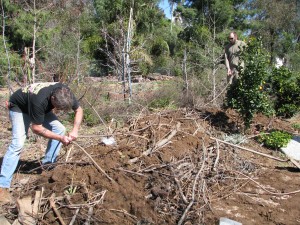
Steve reconnecting the subterranean drip, which runs from a well powered by solar. Because there weren’t large logs, there were a lot of spaces to fill with dirt. Gradually the mound grew and was sloped down to the pathway. Finally a couple of inches of dirt was packed on top. Unfortunately this was mostly clay from the excavation site, but if it had been good soil to begin with, I wouldn’t have needed the hugel bed now, would I? Yes, I did give it a sprinkling of sugar just to get the microbes feeding.

All topped up! There was so much clay that this could have been a big fire pit! The next day I dug up soil from the bottom of the wire cages that were now empty of branches, vines, and sticks. In less than a year since making the wire beds they’d begun to decompose and there was several inches of nice soil at the bottom. I hauled it over to the new bed and topped the clay with the compost.
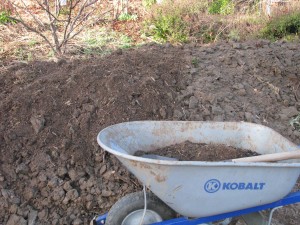
Guess which half has the good soil on it? I want to break up the clay soil so I threw around a cover crop mixture of peas and wheat. The peas will fix nitrogen in the soil, the wheat roots will stabilize and break up clay, I can harvest food from both and then slash and drop the plants to bring nutrition to the soil surface. I also had a bag of mixed old veggie seeds. Last year or so ago I pulled out all my little envelopes of veggie seeds that were very old and mixed them all up. I planted batches around the property and had many things germinate. I still had about 2 cups of the seed left so I threw it around the new hugelbed along with the cover crop. Why not? If the seed isn’t viable, no loss. If it is, terrific! I can always transplant the sprouts if there are too many of any one thing.

Organic cover crop and a bag of old mixed veggie seeds. I watered the seed down, and then raked out the old straw from the Fowl Fortress. Here is a warning about straw: it will germinate. People say straw doesn’t have seeds in it because the seeds are all in the tops which is cut as hay, but they lie. They live in a dream. Straw still has seeds in it and I had a nightmare of a time weeding pathways the first year of the garden because they were all strewn with straw mulch. However if you put straw down for your hens first, they will eat all the seeds, poo on it, kick it around in the dirt, and then you will have a much better quality straw to use. Straw is difficult to get wet, and it needs to be wet when placed on the bed unless you live in a wet climate or have timed the planting to be just before a long soaking rain.

A thick layer of wet straw went over the top of the scattered seeds. Even then it is good to soak the straw first and then apply it to the bed. Some people soak the straw in an enriched liquid, using manure tea, kelp, microbial brews, organic molassas, etc. The mulch acts as an insulator for moisture and warmth (the decaying wood will eventually produce some heat to warm the little plant feet), and a suffocator for weeds. It can also be a home for sow bugs if too thin. In wetter climates the straw layer can be an inch or so thick. In drier climates the straw or whatever you use as a top mulch should be several inches thick or else it will just wick moisture out of the bed. The same rule applys when using newspapers as a mulch. TIP: don’t let your chickens near the new bed! They will ‘rediscover’ their old mulch and start kicking all your work apart!
If I had wanted to plant established plants on the hugelkultur bed rather than seeds, I would have forgone spreading compost and just covered the poor soil on the mound in wet newspaper or cardboard, and then piled on the straw mulch. To plant I would have cut a hole through the paper, added a handful of good compost and planted in the hole.
So the bed was done, and just before a predicted rain event, too. As it rains the water will roll into the bed, be absorbed and held by the soil around the branches which will eventually begin to absorb the moisture as they decay. The seeds will sprout through the mulch and their roots will hold and amend the clay on the mound. Eventually the roots of the apricot trees will reach over towards the hugel bed, and that patch of icky clay soil will become beautiful. All the while I can still grow crops on the raised bed. My three wire bins are empty, an enormous brush pile is reduced to a small mound, and extra dirt found a new home. Plus we all had some fantastic upper body workouts. A winning situation all around.
More hugel beds will be created in troubled spots; some may only be a couple of feet long below a tree’s root line to help with soil drainage while amending the planting bed.
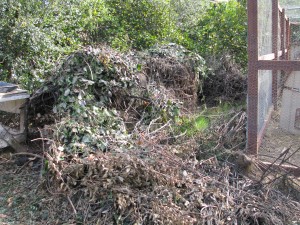
Wire cages filled with old weeds, prunings and vines are terrific for hugels! If you are in an area where the top mulch might wash away in heavy rains, make a latticework of sticks held down with landscape pins or more sticks over the top of the straw. Or cover with wire until the plants begin to sprout; you don’t want the wire to remain on the bed.
So try a hugelkultur bed, big or small. You’ll wonder why you never tried it before.
- Animals, Bees, Birding, Chickens, Gardening adventures, Heirloom Plants, Permaculture and Edible Forest Gardening Adventures, Pets, Photos, Ponds
It Might As Well Be Spring: an Indulgence in Prose
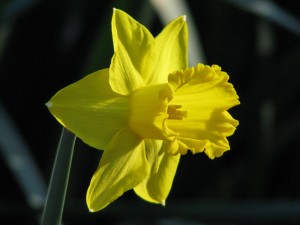
First daffodil, face to the dawn. Mornings find me waking before sunrise, throwing cats off my bed, rousing my elderly dog for her morning ablutions, and scampering down to the hen house in my robe and slippers (and some mornings warm hat and scarf) to feed the hens and the wild ducks, and the tortoise.
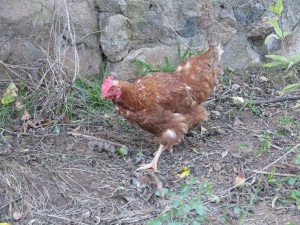
Viola seeing what new seed is available since the night before. Last night when I let Sophie out for her final walk of the night the Santa Ana winds were like a warm caress, riffling through the palm fronds in the dark. Orion sparkled overhead, moving into the position it was in for the birth of both my March babies half a lifetime ago.

Mourning doves in a morning sky. This morning the air was expectant. The garden seemed to emit a trembling energy; an excitement roiling to the surface, but afraid to burst out in full in case of another frost.
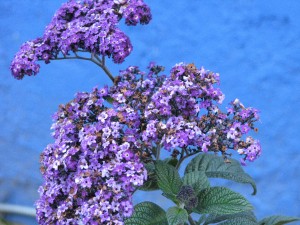
Vanilla-scented heliotrope. Indeed another cold front will be moving in with much-needed rainfall later this week. For now, the bold grasses are up and reckless early stonefruit have blossomed out, much to the joy of the hungry bees.
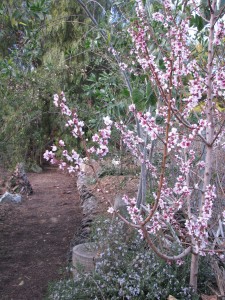
White peach. I could almost hear Browning’s Pippa chanting in my head. But not too much.
The ornamental pear trees all around town are in full glorious bloom. Yesterday while driving from the Community Center to the bookstore there were enough petals strewn in the road as to cause a whirlwind of white as I drove through. An eddy of petals around my car. Joy.
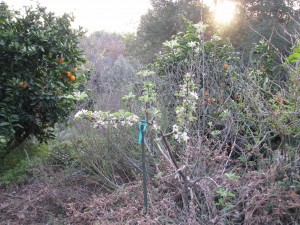
Almond just breaking bud. This weekend is the Great Backyard Bird Count, as well as my two regular bird count days for Project Feederwatch. Before breakfasting I filled seed feeders and enjoyed the show while eating my fresh egg, asparagus, toast and cinnamon tea. Twitterpating is definitely in the air as birds pair up and rival mallards chase each other over the big pond.
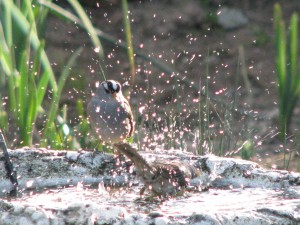
A white crowned sparrow splashing his friend. A Northern mockingbird sips from the bird bath dripper sizing up his territory and listening for new sounds to add to his repertoire. A buzzy rufous hummingbird guards the nectar feeder from the larger and flashier Anna’s. A long-mated pair of crows hang out preening each other on the telephone wire.
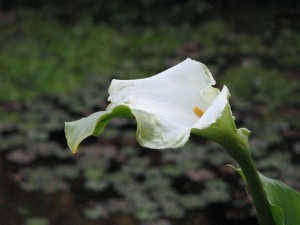
A green-white pond calla. Frogs are croaking amorously in the damp rushes. To my complete joy, far earlier than the bulbs strewn across the property which are just peeking green out of the earth, just outside my window are early daffodils and sweet violets, two of my favorite flowers.
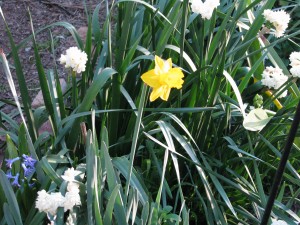
Daffodils, Earlicheer narcissus and a little blue squill. It is still February, and I’m not that great a fan of such a beastly month as February , but for today the paperwork will lie ignored, the cold weather clothes will stay in the laundry basket, and after I take my cat to the vet I will spend the day in the garden (although that isn’t so unusual for me, is it?) listening to the Nuttall’s woodpecker try to drum holes into the telephone pole and smell the scent of Gideon’s trumpet flowers.

Sweet violets. I look forward to tomorrow when I’ll be making two new friends, and to casting seed which will add new life to the garden.

Easter will be early this year. It is all about possibilities, and possibility is definitely in the air today. I will believe Punxsutawney Phil that although it is technically winter, for today it might as well be spring.
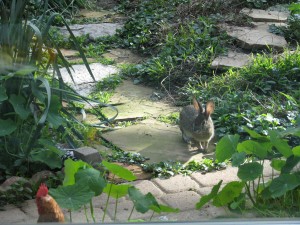
A meeting of the minds. - Gardening adventures, Heirloom Plants, Natives, Permaculture and Edible Forest Gardening Adventures, Soil, Vegetables
Valentine’s in the Garden
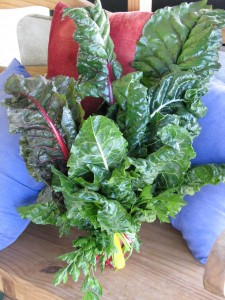
A rainbow chard and parsley bouquet for Valentine’s Day Another gorgeous day in the garden today. I gave a chard bouquet to my friend Lara who has been so kind as to teach me piano over the last two months (I’ve progressed from the ‘clink clink’ stage to the two-handed ‘clink-clink-CLINK’ stage. Lara deserves chard!). My best Valentine’s was receiving my box of organic seeds from Botanical Interests. Yep, ordered too many again. At least it won’t make me fat.

Great seeds! Can’t wait to plant! It was warm enough for shorts, and since my neighbors can’t see me, I indulged for awhile.
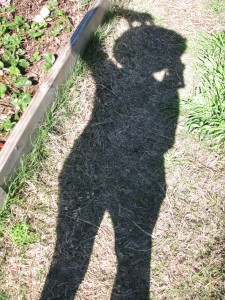
Shorts on Valentine’s Day! (No I’m not THAT short, and go figure what my hand is doing to my hat!) At the end of December I had planted two flats of seeds and stuck them in the greenhouse; one had winter veggies and the other native plants.
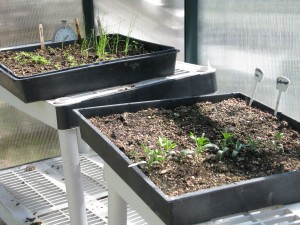
Bladderpod and leeks. A couple of weeks ago I was telling my daughter in college that only one of each had come up so far. She pointed out that the two were curiously linked: bladderpod and leeks! It seems even my garden is a comedian. Today I transplanted the bladderpod into larger containers.

Transplanted bladderpods. Bladderpod (Isomeris arborea) is a true California native living at home in the desert or at the coast and usually in the worst soils. It flowers most of the year even in drought conditions, providing nectar for pollinators and hummingbirds. The plant doesn’t smell so great, but it has wonderful balloon-like pods that rattle when dry. It is a fantastic addition to gardens.
In planting seeds in flats it always looks as if roots are shallow until you take the plant up and find a healthy and sometimes long root system. Don’t let the top growth make you think that the roots aren’t developed.
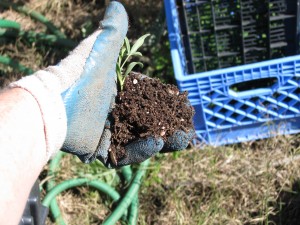
The root ball of this little bladderpod seedling is healthy and full. No more natives are showing their faces in the flat yet, but they have their own schedule and I’ll continue to watch the flat for signs. Just as animals (including humans) respond to circadian rhythms with the 24/hour sleep/wake cycle, plant growth is cued in not only by warmth, but by length of daylight hours. For plants it is called photoperiodicity. You can casually throw that into a conversation over the dinner table tonight and see if anyone notices. A plant’s response to daylight length is called photoperiodic. There is much more to this, and you can read up on it here. So to make a short story longer, I don’t manipulate the light in the greenhouse so I wait longer time than recommended for seeds to sprout just in case they really don’t want to get out of bed yet. I can empathize.
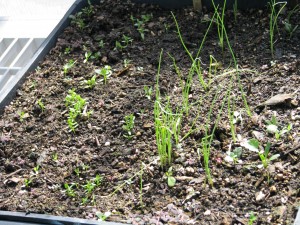
Little celery and parsnip sprouts and leggy leeks that need transplanting, In the veggie flat celery and parsnips have decided to sprout so I’ll transplant them out in a week or two.
Elsewhere in the garden the nitrogen-fixers are working away.
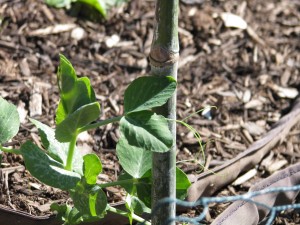
Pea ready to grab onto a bamboo support pole. Fava beans have sprouted from leftover seed from last year and they are already in bloom.
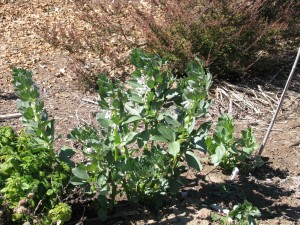
Bees love the blooming favas. The weather is so beautiful that I want to plant the summer veggies… I’m yearning for tomatoes! I will be good and wait a few more weeks until all chance of frost is gone (hopefully the weather won’t be too crazy and frost in March!). Then, look out! Seeds everywhere! And yes, by popular demand I will write about trashcan potatoes.
- Animals, Birding, Compost, Gardening adventures, Living structures, Permaculture and Edible Forest Gardening Adventures, Photos, Ponds, Rain Catching
Frost on the Pathways
It doesn’t often frost here in Fallbrook, which is located about an hour from both the mountains and the Pacific in northern San Diego county. When it does, the fruit growers have to take drastic steps to keep their citrus, avocados and other tender plants from dying. The last frost happened after a long steady rain, just after a thick mulch was applied to all the trails here at Finch Frolic Gardens (thank you, Lori!). I awoke to a magical result: just the pathways had turned white with frost. Beautiful! (You can click on the photos to enlarge).
Frost on the newly mulched trail. Between the two ponds. Ice skating rink for birds. Mr. and Mrs. Mallard enjoying some breakfast scratch. Sophie following the trail Little frosty bridge Past the new little bamboo bridge. Strawberries to Frost: “Bring it on!” These wildflowers survive frost just fine. Winter blooms, too! - Animals, Bees, Chickens, Cob, Compost, Composting toilet, Gardening adventures, Health, Heirloom Plants, Herbs, Natives, Permaculture and Edible Forest Gardening Adventures, Ponds, Rain Catching, Recipes, Salads, Soil, Vegan, Vegetables, Vegetarian, Worms
Southern California Permaculture Convergence! Be there!

Southern California Permaculture Convergence If you are interested in any aspect of permaculture, such as organic gardening, herbs, planting native plants, aquaponics, natural ponds, beekeeping, keeping chickens, and so much more, then you must come to the Southern California Permaculture Convergence. It happens on March 9th and 10th at the Sky Mountain Institute in Escondido. The keynote speaker will be Paul Wheaton, lecturer and permaculturalist extraordinaire of www.permies.com fame. Oh, and I’ll be one of the many speakers as well (cough cough). The Early Bird special of only $50 for both days ends at the end of January, and then the price will rise, so buy your tickets now!
Also, for a full-on demonstration of taking bare land and creating a permaculture garden, there will be a three-day intensive class taught by Paul Wheaton on site the three days prior to the Convergence.
You can read about the convergence here at the official website, which will give you the link perm.eventbrite.com where you may purchase tickets. Also visit the SD Permaculture Meetup page to see all the free workshops that happen monthly all over San Diego.
This convergence is such a deal, you really shouldn’t miss it! And such a bargain, too. One of the best things I find that come out of these convergences is the exchange of ideas and networking among the attendees, and all the practical information you can take home and use right away. One of the largest parts of permaculture is building community, which means sharing with and assisting others.
Really. Don’t miss this! Tell your friends!
- Compost, Gardening adventures, Natives, Permaculture and Edible Forest Gardening Adventures, Soil, Vegetables
Gardening secrets: Epsom salt and sugar

This veggie bed soil isn’t very active. So I buried frosted tomato vines in it and sprinkled on my powerful duo, and in a month I’ll plant seeds. Gardening shouldn’t be expensive. If you believe everything you read, especially those wonderful gardening catalogs and even advice from professional gardeners, a garden could be quite an investment. Talk about golden carrots! I have spent my fair share of money for gardening products in my time. Then this permaculture stuff got into my head and it makes me rethink everything. Permaculture proves that gardening shouldn’t be labor intensive, just labor-wise. Make things work for you and let plants get on with what they want to do. Makes some forehead-slapping sense to me.
Organic fertilizer is a plus for firing off poor soil, but it is expensive. There are two other very inexpensive household products that you can use to really charge your soil, promote growth, make fruit sweeter, reduce some weeds, release the bound-up vitamins and minerals in the soil, promote world peace… well, I’m getting a little carried away, but not by too much.
Epsom salt is named after Epsom, England, where the active ingredient Magnesium sulfate was originally created. Not found naturally, it must be processed, now most often from dolomite. Dolomite is mined in the United States and internationally. The sustainability of dolomite mining and the environmental impact of mining, processing and shipping Epsom salts may be something to consider, if you worry about the locality of products you purchase. I don’t know what impacts those are. Epsom salts can actually be made at home by chrystalizing magnesium sulfate, but I’m thinking that although I enjoy do-it-yourselfing, this is a little too much.
Epsom salt is inexpensive and readily available. It is recommended for tomatoes, peppers and roses, but I use it around citrus trees, in the veggie beds, and anywhere leaves are looking sickly. The Epsom salt bag recommends sprinkling 2 tablespoons around the base of each plant, so you can see a little goes a long way. It is also a wonderful bath salt which eases sore muscles and leaches impurities from your skin (often recommended as a diet aid because of this). (Also if you have a greywater system, your magnesium-enriched bathwater will flow out to nutrify your plants! Such a deal!) Some sites tell you never to take it internally; the bag and others recommend it for… let’s say… loosening things up inside. It is also used as a curdling agent in making tofu. There is a relationship between calcium and magnesium whether it be in the soil or in our bodies. Taking too much calcium without enough magnesium can lead to many health problems such as arthritis and hardening of the arteries. Don’t take more than a ratio of 2:1. (Dairy products don’t have that ratio, so if you drink milk you may not be absorbing the amount of calcium you thought you were). Also, calcium and potassium compete with magnesium for uptake into roots, and even though your soil samples may indicate enough magnesium your plants may not be receiving enough. If you have heavy clay soil, you could have a ratio as high as 7:1, yet in sandy soil you need more magnesium to hold soil together so you can go to about 3:1. Here are some good sites for looking into the science behind it if you’re interested: National Gardening Association, a book excerpt here which goes into more details about how its made and how to use it medicinally, and even a site about how to make crafts with it.
Also, don’t let the name confuse you. Epsom salt is Magnesium sulfate, not salt as in table salt which is Sodium chloride. Applying Epsom salt to the ground is not like applying, well, salt. Applying Sodium chloride to your soil is to kill it. I’ve read and overheard inexperienced gardeners say that they’ve poured salt on weeds because, after all, it comes from the ground so it shouldn’t do any damage. Ummm, no. Invading armies would salt the fields of their enemies so they couldn’t grow crops there for decades. Heavy salt in the soil is a huge problem (which, of course, if you’ve been paying attention to past blogs you know can be readily solved by….. what? I’ll give you a chance to fill that in and reveal the answer at the end!)
As for my other ‘secret’ ingredient is sugar. Yes, my soil is on junk food. Actually using organic molasses dissolved in rainwater would be best, and I have done that when making a microbial brew, but I am but one person with a thin purse so sugar it is. Why sugar? It is a complex carbohydrate which plants need to produce protein, starch and fats. Plants produce their own sugar through photosynthesis, and by secreting their own sugars through their roots determine which microorganisms they want to thrive near them. I use a little sugar on ailing soil; all those millions of microbes and fungusey things that are in the soil get a jump-start with something sweet. Have you ever made bread and mixed a little sugar in with the yeast to proof it? Same difference. The soil critters feed off the sweet, multiplying like crazy and making your soil turn into healthy goodness. If your soil is healthy, you don’t need it. When the sweet is gone they munch on organic materials processing them more quickly and opening up all those locked nutrients in the soil. If there isn’t enough for them to eat and there is a die-off, then their little bodies become nutrients for the soil (as they would anyway). To put this into perspective, let me relay to you an interesting fact I learned in my Permaculture Design Course. When a field is plowed and farmed, the first year crops are good. Each successive year that it is plowed and farmed the fertility is less and the crops worse until the ground is barren. That is because with the first plowing or tilling gajillions of microbes are slaughtered and it is their dead bodies that fertilize the crops. Each successive year there are fewer microbes available to slaughter until they are all gone and the soil has become dirt. And then we have dust bowls and run-off, erosion, loss of the water table, the drying up of streams, climate change, universal discord… well, you get the picture.

Climbing Don Juan here was a miserable, spotty rose last Spring, while all his friends were tall and lovely. I added Epsom salt and sugar, and he fought off the black spot and is thriving. Only lightly sprinkle the sugar around your soil; too much can hurt plants. I have used sugar successfully to kill off an invasion of nutgrass, something about which I read on the Internet. This sedge turned up in my pathways and although I hand weeded the little guys (I didn’t eat them although they were cultivated as a crop in Egypt) they just kept on coming, even after I had put plywood over the top for awhile. So I sugared them then threw the plywood back on, and Bob’s your Uncle, no more nutgrass in that area. I envisioned millions of little mouths biting away at the nutgrass bulbs underground… I need to stop thinking about that. What really happened is that the microbes fed off the sugar and multiplied wildly to a point where they locked up the available nutrients in the soil which non-natives need to grow. Native plants won’t be bothered because they can thrive in poor soil. Here is an article about the research behind sugaring to prevent weeds. I lightly add sugar around established plants that aren’t doing well, and water into new vegetable beds where the soil isn’t vigorous yet and allow the beds to sit awhile before I plant seeds.
Refined white sugar is of course empty calories. Any dissolved sweet will work well, too. Beet sugar, agave syrup, leftover pancake syrup, sorghum syrup, honey, molasses, diluted jelly… use your imagination and your pantry. The more nutrients in the sweet the better for your soil, but also the more expensive it will be. If you are using sweet for houseplants then you should be wary of possible interest by house ants. Outside it isn’t a problem.
So share your bath and your jelly donut with your garden and you’ll both be happier and healthier!
(Answer: compost! You knew that!)
- Compost, Gardening adventures, Hugelkultur, Permaculture and Edible Forest Gardening Adventures, Soil, Vegetables, Worms
Lazy Composting
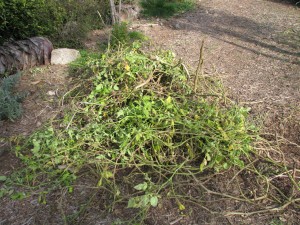
Tomato vines… what to do? I have a Rubbermaid compost bin where I dump my kitchen scraps, and a nifty three-bin pallet compost bin for larger stuff, as well as wire cages where I’ve heaped tough weeds and vines.

My wire bins floweth over. All of these methods of composting are great. They also require some physical work that I’m wary of these days. I still keep my old raised veggie beds lined with chicken wire and use them for controlled or experimental crops and extra seed. The soil in them settles after awhile and because I don’t turn my compost heaps enough I don’t produce enough compost to haul over and refill the beds.

Soil is at a low level in the raised beds. Today I decided to try mini hugelkultur beds. Hugelkultur is the practice of heaping wood and other organic matter, covering it with soil and planting directly on the pile. The berm catches water and the buried wood holds the moisture, releasing it slowly to the plants and gradually decomposing to create beautiful soil. When I planted my strawberry bed two years ago I buried old lime tree logs all along the edge. Now that soil is beautiful as the logs decompose, helping to acidify the soil for the acid-loving strawberries, and holding moisture by the roots. Some strawberry plants have rooted right in the logs.

Strawberries have rooted runners directly into the rotting lime logs. The soil around the logs is perfect. In one of my long raised veggie beds I cleaned out the frosted tomato vines and what sweet potato vines were left after our harvest.

Frosted tomato vines: treasure, not trash! I don’t like to disturb the soil because that kills microbes, fungus and worms, but this soil hadn’t been perfect to begin with.
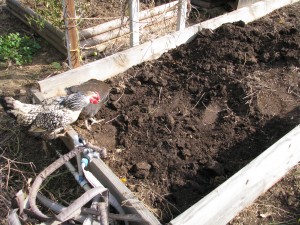
Digging up the soil and trying to protect the worms from the persistant chickens. I shoveled out a portion of the soil then cut up the tomato vines and dropped them in the bed.
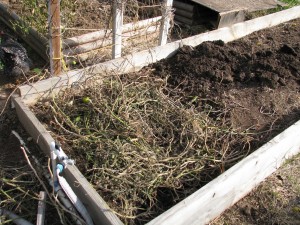
Heaping on the vines. Then I shovelled the dirt back over again, and made my way down the bed until all the vines had been covered.
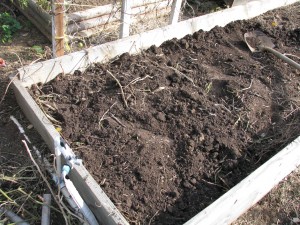
A few vine ends stick up, but that’s okay. If I had more soil I’d bury them more. I also sprinkled on sugar and epsom salts, to feed the microbes and add magnesium (I’ll blog about these two garden wonders another time).
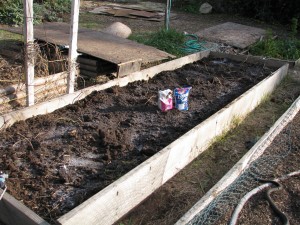
Magnesium-rich epsom salts and sugar (organic molassas is better) invigorate the soil. Burying garden leftovers like this does several things. It quickly feeds the microbes and worms in the soil without the critters having to gnaw on them from underneath or wait until the plants decompose more. The vines keep the soil from compacting and help hold moisture when it rains.

I cut the tomato vines and leave the stem and roots. Worms love roots. The vines had taken nutrients up into the leaves and fruit, and now many of those same nutrients are being returned to the bed in which they grew. Keeping the soil moist from underneath is a valuable way to protect seedlings from bugs. Top mulch I have found to be a nursery for damaging pill bugs, which you might call ‘rolly-pollies’ or sow bugs.
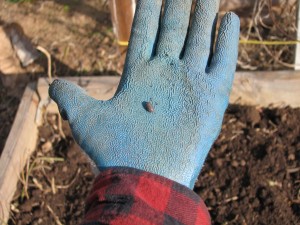
A sow bug on my glove (No, I’m not a Smurf). Although experts say that sow bugs don’t directly damage plants and fruit but rather feed off of already damaged produce, I have my doubts. If so, I believe that mine hired another bug or bird to damage about half of my strawberry crop last year so that they could feast on them.
Because decomposing green matter will initially take nitrogen from the soil, I’ll let this bed sit for a couple of months before planting, or if I can’t stand to wait I’ll plant nitrogen-fixing peas as a cover crop. I won’t repeat the same crops in this bed because it is smart to rotate families of veggies for many reasons, including pest control. Whatever I put in here, however, will be a mix of seeds.

I spy a sweet potato that hid the harvest by growing under through the wire and under the board! Another bed I’ve been playing with had been empty and needed soil. Over the last season I’ve thrown in garden debris and a layer of llama poo topped with sweet potato vines. Last week I balanced a piece of plywood over it. Today I took a peek and the vines are covered with bugs decomposing in the moist darkness of the plywood as the heap gradually settles. I’ll leave it be and keep checking on its progress.

Plywood balanced on piled garden debris I have more lazy composting ideas for the entire property. I’ll let you know.
- Compost, Gardening adventures, Giving, Health, Natives, Permaculture and Edible Forest Gardening Adventures, Soil, Vegetables
Stinging Nettle and World Peace
One of my very good friends asked me what to do about a proliferation of stinging nettle in her yard. There is a creek running through the bottom of her property, and while once there had been Jimson weed and other natives growing there, now there is just nettle which is spreading to her lawn. Her hand hurt for a day from inadvertently pulling some out bare-handed. Her neighbor had told her that “nettle was bad” and would take over. She was laying cardboard on some of it, but was afraid that wouldn’t be enough.
One of the main practices of permaculture is to take what is considered to be a problem and look at all sides of it, just as in Zen you must think like your enemy, or in some Native American beliefs you must walk a mile in another’s shoes.
Fortunately I knew some things about nettle, and told her that nettle was not only edible once the acid had been blanched away, but highly nutritious. Here is a good description of what it can do. It is a superb compost enervator. The disappearance of the other natives by the streambed was evidence that someone upstream had sprayed an herbicide that washed downstream and killed everything. The prolific growth of stinging nettle, which is an indicator plant for high nitrogen in the soil, showed that someone’s high nitrogen lawn fertilizer came the same way.
Nettle’s acid is simply an excretion by the plant on the hairs along its stem to discourage browsing animals. The sting is immediate and temporary, unlike poison oak which has an irritating oil that can spread with touch and takes a few days to cause a rash. In nature often the cure grows near the problem, and therefore both the riparian plants mint and plantain can be rubbed onto the area to alliviate the sting, but soap and hot water works just as well. Nettle reproduces only by seed, not by rhizomes or other invasive tactics. It likes water therefore it takes root in lawns which are watered frequently and are fertilized with nitrogen.
My friend is always ready to embrace new information, especially where nutrition is concerned, and immediately stopped looking at nettle as a potentially dangerous invader of her property, to an indicator of other problems (stream pollution) and a health goldmine. To control what she doesn’t use she knows she can cut it down before it seeds and it won’t spread (and the cut plants will charge her soil), and if she wanted to restore the wetlands area she could continue to lay cardboard to cover most of the nettle, then top them with soil and straw, cut holes through to the dirt and transplant native riparian plants into the sheet mulch. There are no invaders, no monsters in her yard.
While pulling ragweed out of the pathways at my place with another friend (I have become so rich in friends this last year!), I told her about the nettle. Her reply was that while she worked in the garden she’d see things in a new perspective. Knees to the earth, eyes choosing between ragweed and sprouting wildflowers, lungs full of the scent of good soil, permaculturalists steer away from the stereotypcial gardening approach and see benefits where others see problems.
And this is what this post is all about: applying permaculture practices to everyday living, from personal to global thinking. In permaculture there are no invasives, no bad guys. Even my hated Bermuda grass is a plant in the wrong place, spread because people insist on seeding lawns with the stuff. Its function is to hold soil and moisture and break up hardpack. It does this admirably well, only I don’t want it in my garden. In permaculture, problems are like little moons where you see nothing but black on the dark side until you turn it to see the incredible sunlit topography on the other side, and understand that all those details are there on the dark side as well. A problem is just an opportunity for creative thinking; a resource whose purpose isn’t clear as yet. Therefore there are no ‘weeds’, no stereotypes.
So take these phrases and look at them with the eyes of permaculture: Teens are irresponsible. Old people are antiquated. Dark-skinned people are dangerous. Light-skinned people are dangerous. The government is out to get us. All businesses are bad. All politicians are corrupt. Men are incompetent. Women are hysterical.
Imagine these phrases as balls you can turn in your hand, like little moons. Examine, understand, see that anger and violence all stems from fear. Look at all sides of the phrases and see that they cannot be true. Just as stinging nettle isn’t an invasive plant out to get people, but a plant rich in potentials doing its job, then any potential imagined threat to our safety can be understood and appreciated until we no longer face it with fear. We hire and train youths. We listen to the life experience of the old. We vote to change the government. We support small businesses. We offer training and workshops to teach. We offer safe, sane gardens in which to meditate. We produce good organic food to nourish brains and bodies and activate good health.
By gardening with permaculture in mind we can so easily imagine a more peaceful world, both for our small personal worlds and on a global scale. Therefore it is imperative that we introduce others to permaculture, for the saving of the earth and of ourselves.

